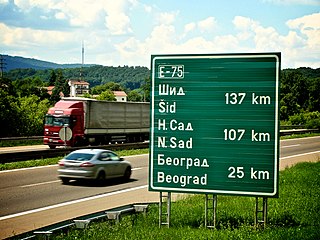Romanization of Serbian

The romanization or latinization of Serbian is the representation of the Serbian language using Latin letters. Serbian is natively written in its own Serbian Cyrillic alphabet, a variation of Cyrillic.
However, Gaj's Latin alphabet is also used in Serbia as the second official alphabet and the two are directly and completely interchangeable.
The Latin variation of the Serbian alphabet is identical to those used in Bosnian and Croatian language.
Use of romanization

Serbo-Croatian was regarded as a single language since the 1850 Vienna Literary Agreement, to be written in two forms: one (Serb) in the adapted Serbian cyrillic alphabet; the other (Croat) in the adapted Croatian Latin alphabet,[1] that is to say Gaj's Latin alphabet.
Đ was added to Gaj’s Latin alphabet by Đuro Daničić in the 19th century. The lexeme soon found its way into the Latinic transliterations firstly of Serbian (through the Serbian and Croatian historical chapters) and then Macedonian (its Latinic transliterations heavily influenced by Serbo-Croat from the Yugoslav period) and Bosnian to represent the affricate [dʑ]. Đ is considered a distinct letter, and placed between Dž and E in alphabetical order. Its Cyrillic equivalent is Ђ ђ. Its partial equivalent in Macedonian is Ѓ ѓ (as only some regions contain the /dʑ/ sound). When a true đ is not available or not desired, it is transcribed as dj in Serbo-Croatian, and as gj in Macedonian.
Latin was not initially taught in schools in Serbia when it became independent in the 19th century. After a series of efforts by Serbian writers Ljubomir Stojanović and Jovan Skerlić, it became part of school curriculum after 1914.[2] The government of socialist Yugoslavia made some initial effort to promote romanization, use of the Latin alphabet even in the Orthodox Serbian and Montenegran parts of Yugoslavia, but met with resistance.[3] The use of Latin did however become common among Serbian speakers.
Later still, in 1993 the authorities of Republika Srpska under Radovan Karadžić and Momčilo Krajišnik decided to proclaim ekavian and Serbian Cyrillic to be official in Bosnia and Herzegovina, which was considered grotesque both by native Bosnian Serb writers at the time and the general public, and that decision was rescinded in 1994.[4] Nevertheless, it was reinstated in a milder form in 1996, and today still the use of Serbian Latin is officially discouraged in Republika Srpska, in favor of Cyrillic.[5]
Today Serbian is more likely to be romanized in Montenegro than in Serbia.[6] Exception to this include Serbian websites where use of Latin alphabet is often more convenient.
Romanization of names
Serbian place names
Serbian place names are consistently spelled in Latin using the identity mapping that exists between the Serbian Cyrillic alphabet and Gaj's Latin alphabet.
Serbian personal names
Serbian personal names are usually romanized exactly the same way as place names. This is particularly the case with consonants which are common to other Slavic Latin alphabets - Č Ć Š Ž and Dž.
A problem is presented by Đuro Daničić's addition of Đ/đ (pronounced [dʑ], similar to the "dj" sound in "jam") which is still sometimes represented by "Dj" (as did the original Gaj's alphabet), so "Dj" is still sometimes encountered in rendering Serbian names into English, though strictly Đ should be used (as in Croatian).
Foreign names
Foreign names are generally retained in Croatian without applying Gaj's Latin alphabet. So, for example Winston Churchill and Charles de Gaulle appear in Croatian history books without attempts to "slavicize" the spelling. In Serbian romanization however, "George" becomes "Džordž," Churchill and de Gaulle become "Vinston Čerčil" and "Šarl de Gol" (directly transposed from Винстон Черчил and Шарл де Гол in Serbian cyrillic script).[7]
An exception to this are place names which are so well known as to have their own form: just as English has "Vienna, Austria" (and not German "Wien, Österreich") so Croatian and romanization of Serbian have "Beč, Austrija."
References
- ^ The World and Its Peoples 2009 - Page 1654 "Until modern times, Serbo-Croat was regarded as a single language, written in two forms: one (Serb) in the Cyrillic alphabet; the other (Croat) in ...
- ^ Naimark, Norman M.; Case, Holly (2003). Yugoslavia and Its Historians: Understanding the Balkan Wars of the 1990s. Stanford University Press. pp. 95–96. ISBN 0804745943. Retrieved 2012-04-18.
- ^ The Social construction of written communication Bennett A. Rafoth, Donald L. Rubin - 1988 "Yugoslavian efforts to romanize Serbian (Kalogjera, 1985) and Chinese efforts to romanize Mandarin (De Francis, 1977b, 1984; Seybolt & Chiang, 1979) reveal that even authoritarian regimes may have to accept only limited success when the"
- ^ Greenberg, Robert D. (2004). Language and Identity in the Balkans: Serbo-Croatian and Its Disintegration. Oxford University Press. pp. 78–79. ISBN 0191514551. Retrieved 2012-04-18.
- ^ Greenberg, Robert D. (2004). Language and Identity in the Balkans: Serbo-Croatian and Its Disintegration. Oxford University Press. pp. 82–83. ISBN 0191514551. Retrieved 2012-04-18.
- ^ One thousand languages: living, endangered, and lost - Page 46 Peter Austin - 2008 "Croatian and Bosnian are written in the Latin alphabet; Serbian in both Serbia and Bosnia is written in the Cyrillic alphabet. Both scripts are used for Serbian in Montenegro."
- ^ Bosnian, Croatian, Serbian, a grammar: with sociolinguistic commentary - Page 3 Ronelle Alexander - 2006 -"... name in original Serbian (Cyrillic) Serbian (Latin) Croatian George Џорџ Džordž ; George Mary Мери Meri Mary ; Winston Churchill Винстон Черчил Vinston Čerčil Winston Churchill ; Charles de Gaulle Шарл де Гол Šarl de Gol Charles de Gaulle ;"
